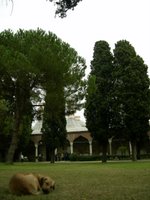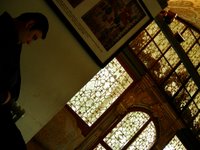7.15am
It is drizzling outside. Our second breakfast is had, still on the terrace, under a small canopy. The rain is very slight, or
kin-min as D has always called this sort of drizzle. By the time we set off, it has stopped, but grey clouds hang overhead far more suggestively than the day before. We are headed for Topkapi Palace (just behind the Ayasofya), and like good LP and TTP readers, we mean to get there early to grab a spot in the first set of people allowed into the Harem. Pre-Topkapi info in short:
It is a Palace, a huge palace.
Ottoman.
Functional till early 20th century.
It contains palace grounds, different buildings of the palace, the famous Harem and a treasury Museum.

These last two are tickets over and above the YTL10 to enter the Topkapi Palace grounds. All told, if we are to buy tickets for the three of them, we’d spend about 45Euros between the two of us (!). So the treasury has been, already, struck out. Shrugged our shoulders, we did, back home deciding this. On a budget one has to live with these things.
At the ticket counter, I start to waiver. Weakness creeps in- “Should we just go the whole hog, D?”. Dither. Counter reached. Main entry obtained. Step back. Dither. Stand. Look at other person. “Ah, f*** it”. We buy the Treasury ticket, and we shall not regret it. In a flash we are at the Harem entrance, buying the ticket there. People have audio guides, outsized cellphone-like things that you can punch numbers into and listen to relevant info. But this is a guided tour (as part of the ticket), and we are first in line at the Harem Door. It is not 10am yet.

The Harem is exactly that- a large area that used to house all of the Sultan’s women. Including his mother. In fact, she was the one who would choose women for him. With hundreds (literally) to choose from, I doubt he could complain- in fact there were so many that many of them entered as virgins and stayed as virgins. There were no males allowed (except the princes who were in secluded quarters for fear that all the women would try and kill of others’ sons!). All the guards were eunuchs. Black eunuchs from Africa. The only male in the place was the Sultan.

It sounds all funny and bizarre now but walking through the rooms, bathrooms and corridors, with the guide (who is excellent) telling you beguiling stories, the extent of strangeness and disconnect from that time, that world, that way of living, truly boggles the mind. D listens to all the stories closely, I less so- I am busy trying to take pics. The tour is over in less than 3/4ths of an hour, but it seems longer- in a good, immersed way.

Outside, the palace grounds stretch out all around us- manicured gardens and beautiful trees- old, old trees. There are tour groups everywhere but the palace is huge enough to let you ignore it- it is divided into sprawling ‘courts’. We stroll through the edge of the Second Court, almost alone, waiting for a loud guide-voice and its owner to pass us by before continuing on to the Palace kitchens, ming vases, gifted model ships in gold and silver and a cold, sleeping dog. I am feeling tired today, I don’t know why- like body-ache sort. But I brave on!

There is the very ornate
Divan Salonu or Imperial Council Chamber where the Council would discuss matters of sultanate-shattering importance, and the Sultan would sit behind a grill and listen in. History, it would seem, can be universally sleep-inducing. Or at least on guards.:)
The Third Court houses the Treasury, but before that we walk to a display of some religious items. Curious but not overly excited, we are both amazed by some of the things we find. These are called the Sacred Safekeeping Rooms. Decorated by
iznik tiles that we have already gazed at in the Harem, it has the holiest of things- Prophet Mohammed’s sword, tooth, footprint in clay, his leather sandals and strands of his hair , a carved door from Mecca besides much more. Most of these are scarcely fathomable, and thus fascinating.
When we finally make it to the Treasury (all four halls of it), we are so thankful. Of course neither the Sacred Rooms nor the Treasury Museum allow photography (aaargh). At one point we decide to jot down some of the things we have seen in the museum lest we forget them (forget exactly
what we saw that is, not the visuals themselves). So here you go:
- an
86 carat diamond surrounded by 49 other diamonds. SPECTACULAR. That’s it. It is the world’s fifth largest and is called the Spoonmaker’s Diamond because it was found in a rubbish dump and purchased by a peddler for three spoons! By the way, D ‘wants’ it. Sure. You won’t be able to sell me and get one of the 49, forget the big fella.
- The famous Topkapi Dagger- I wish I could hold it. (this was what the
film in ’64 was about, and the
film in 2006 will be)
- A HUGE sword that could be upto 1400 years old, or at the very least 600 years.
- The arm of St. John the Baptist. Yes, the
arm. It is cased entirely in gold except the back of the palm where you can see the
fingers bones. Next to it, his skull. Bizarre, to say the least.
- Mega sized ‘pendants’,
aigrettes, lots of ornate thrones, gorgeous medallions from all over Europe, a whole dish full of emeralds…the list goes on.

The Fourth Court has beautiful views of the Marmara Sea and the Bosphorous at its north-eastern side, while from the other end you can look out to the Golden Horn and see the striking Galata Tower.


This is from a marble terrace with a pool and a couple of structures that are covered in beautiful
iznik tiles. Entire walls are covered in these lovely- and expensive- tiles.

It is the back end of Topkapi Palace, and soothing despite some crowds. We take photos, get photos taken, and start to feel hungry. Somewhere on the other side of a long but pleasant walk back through the all the Courts lies lunch. If we aren’t so hungry, we might just linger. But it is about 2.30pm (we walked in at 9.30!), and we must leave these beautiful, sprawling, grand grounds for less lofty purposes.
topkapi photosin: travel / turkey / turkey travel / istanbul / topkapi / dna day2
 one long street. As we begin the walk, we notice yet again the deserted look this street, too, wears. It is nearing iftar time again. We chance upon an open shop and buy some water and coke for later, and continue on what seems to be a completely dead stretch- shutters are down and doors are shut. It is only after a while do we realise that it is also Sunday- so this market is shut for the day anyway. It is a great walk- all downhill, all cobblestoned, and
one long street. As we begin the walk, we notice yet again the deserted look this street, too, wears. It is nearing iftar time again. We chance upon an open shop and buy some water and coke for later, and continue on what seems to be a completely dead stretch- shutters are down and doors are shut. It is only after a while do we realise that it is also Sunday- so this market is shut for the day anyway. It is a great walk- all downhill, all cobblestoned, and  At Eminonu, D finally has her first doner kebap. It is only Day 2, but she’s been thinking about these (very cheap) snacks since we began planning on Turkey. It sure is cheap- only YTL 1.5, less than one Euro! She likes it but less than she hoped- the bread is crusty (though soft from the inside), and it takes a toll of the roof of her mouth!
At Eminonu, D finally has her first doner kebap. It is only Day 2, but she’s been thinking about these (very cheap) snacks since we began planning on Turkey. It sure is cheap- only YTL 1.5, less than one Euro! She likes it but less than she hoped- the bread is crusty (though soft from the inside), and it takes a toll of the roof of her mouth!



























